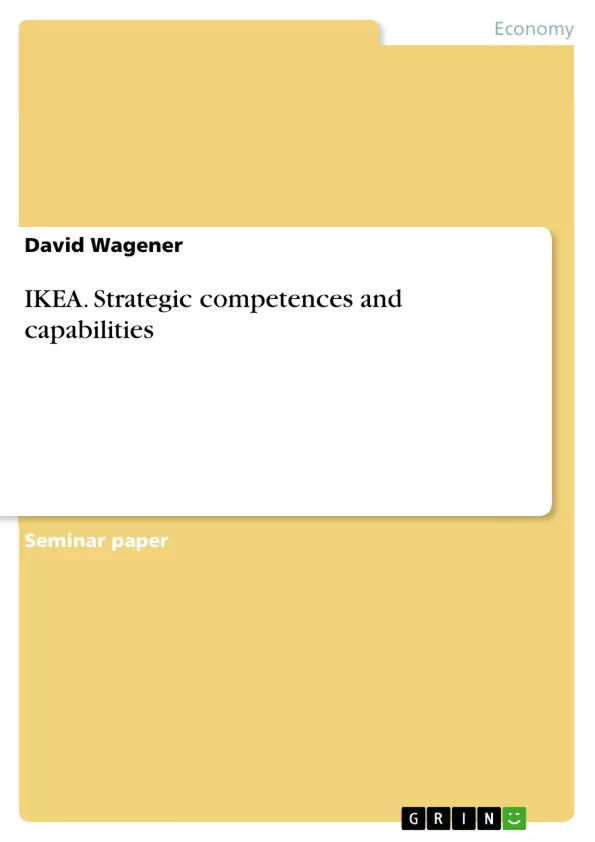231 stores in 24 countries, 522 million visitors during one year and nearly
20 billion euros in sales make IKEA the most successful furniture retailer
in the world (IKEA, 2007; Sloan, 2007). In addition this is achieved
without taking advantage of people or the environment, as one of IKEA’s
policies is to have an overall positive impact on both (Barner, 2007).
But why is the Sweden-based company so successful? And how did it
become that way? Which strategic issues did IKEA face? What are the
values, resources and competences the company bases its operations on?
In order to answer these questions this work uses two strategic
frameworks. For the historic development of the company the ‘dynamic
competence and capability framework’ is used. Furthermore the competitive
edge IKEA has in comparison to its concurrence is explained with
the ‘static competences and capabilities framework’, which is based on a
company’s special set of resources. Within this latter framework there is
an emphasis on knowledge as a fundamental resource and on knowledge
integration, which is separately discussed.
The remainder of this work is therefore structured as follows. In the
second section the frameworks of static and dynamic strategic competences
and capabilities are explained. Afterwards, in the third part, the
dynamic model is adopted to IKEA by applying it to some of the most
important strategic decisions that led to the success of the company.
Furthermore this paper is seeking to evaluate IKEA’s current resources,
competences and capabilities within the static competence and capability
framework. Eventually the integration of knowledge at IKEA is examined.
The analysis finishes with a conclusion revising the main points.
Inhaltsverzeichnis (Table of Contents)
- Introduction
- Strategic competences and capabilities
- IKEA
- IKEA's dynamic competences and capabilities
- IKEA's resources, competencies, capabilities
- Integration of knowledge
- Conclusion and outlook
- References
Zielsetzung und Themenschwerpunkte (Objectives and Key Themes)
This work examines the strategic competences and capabilities of IKEA, aiming to understand the factors behind its success. It analyzes both the historical development and the current competitive advantages of the company, drawing upon theoretical frameworks of static and dynamic competences and capabilities.
- The role of strategic competences and capabilities in business success
- The application of static and dynamic competence frameworks to IKEA's history and operations
- The importance of knowledge integration and its role in building sustainable competitive advantages
- The impact of IKEA's resources, competencies, and capabilities on its market position
- The company's ability to adapt to changing market conditions and maintain its competitive edge
Zusammenfassung der Kapitel (Chapter Summaries)
The introduction provides an overview of IKEA's success story, highlighting its global reach and commitment to sustainability. It also introduces the two strategic frameworks used throughout the analysis.
The second chapter discusses the theoretical foundations of static and dynamic competences and capabilities, drawing on the work of scholars like Chandler and Grant. It emphasizes the role of knowledge as a critical resource and explores the importance of knowledge integration within organizations.
The third chapter applies the dynamic competence and capability framework to IKEA's history, examining key strategic decisions that contributed to its success. It also analyzes IKEA's current resources, competences, and capabilities within the static framework, highlighting the company's unique knowledge base and integration practices.
Schlüsselwörter (Keywords)
The core keywords of this work include: strategic competences, capabilities, dynamic capabilities, static capabilities, knowledge integration, IKEA, sustainable competitive advantage, resource-based view, organizational learning, and market adaptation.
- Quote paper
- David Wagener (Author), 2008, IKEA. Strategic competences and capabilities, Munich, GRIN Verlag, https://www.grin.com/document/113429



